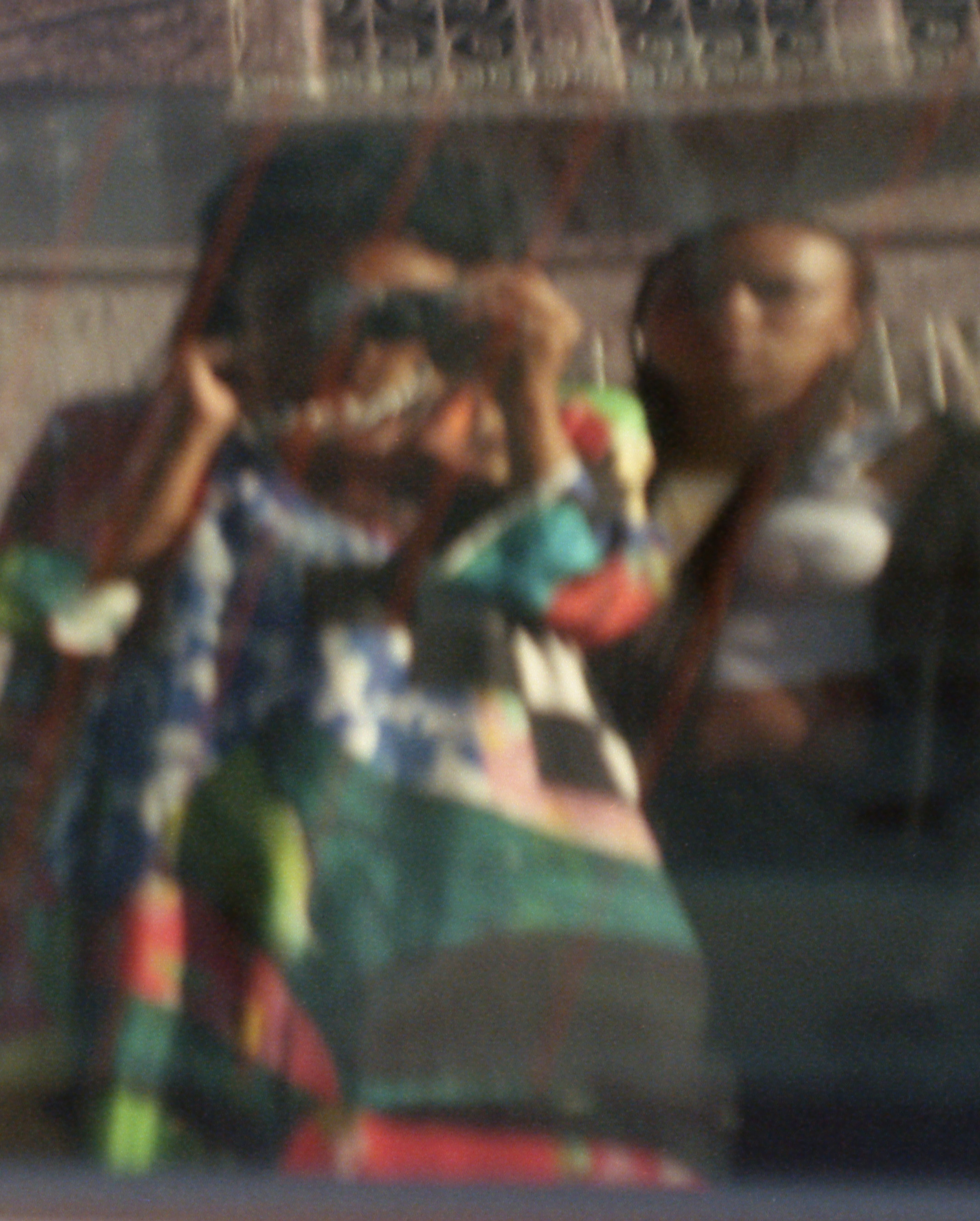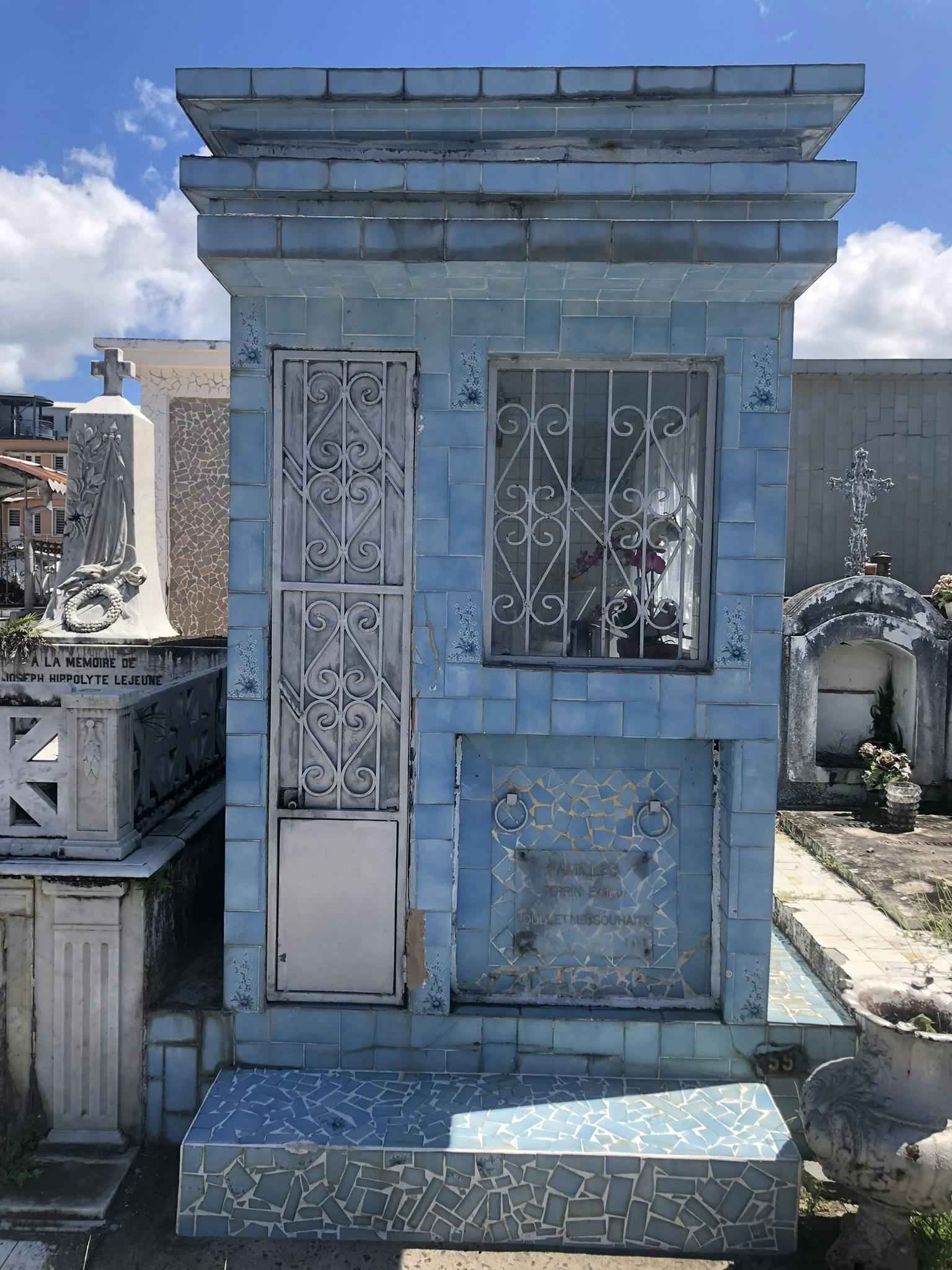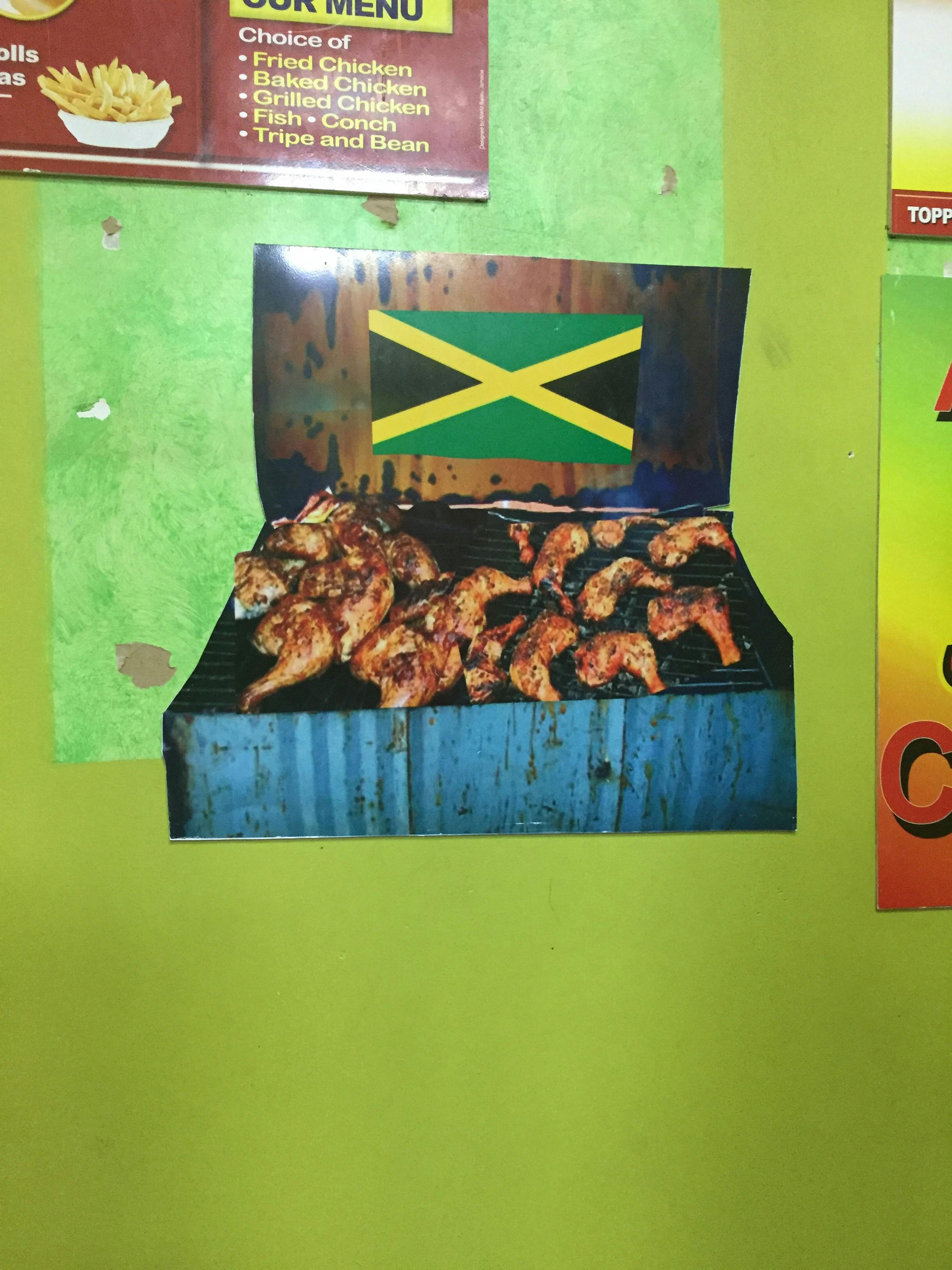
ARCHIVES BEYOND AUTHORSHIP:
An Interview with Sucking Salt
Words by Ella Ray
Images by Sucking Salt
I was initially introduced to Sucking Salt–a collaborative project that archives and researches Caribbean architecture and aesthetics, led by artists Shani Strand and Zenobia–about a year ago. A friend dm’ed me their video What is Caribbean Architecture? with the note: “you would like this.” Published through PIN-UP Magazine in conjunction with Akeem Smith’s exhibition No Gyal Can Test, the video-work is equally melodious and educational, diving deep into the usages of concrete and how the practical application of the material in the Caribbean “does not oppose its aesthetic pleasure.” The cut and dry nudge toward their project worked and I found myself engrossed in what felt like endless still and moving images of churches, homes, staircases, grates, and cemeteries. As an art historian who nearly failed an architecture history class in college due to my issues with Western architectural (and frankly, art historical) pedagogy, I was refreshed by Sucking Salt’s approach to considering the material and social histories of buildings. No structure just simply appears and these artists reflect both a rigor and an ease with their approach, acknowledging the on-going colonial project–often made visible through the erection of architecture or the materials available–without centering its enacters.
Quite a bit of Sucking Salt’s research can be found on Instagram (@sucking.salt). Combining images made while traveling with those pulled straight from the internet or sent to them by family and friends, their feed documents structures across the Caribbean. Some posts zoom in on spider web grates on a home in Sav la Mar, Jamaica and others explicitly name the architects, materials, sculptors, and economies behind specific places/spaces.
Through a few video-calls, a lingering email thread, and a corrupted audio file I got to know Sucking Salt and inquired more about the collective’s beginnings, their goals for the archive, and where their studio practices and this collaborative project meet. In our conversations, it became apparent that this archive is an intimate space for Shani and Zenobia. Shani is first generation Jamaican-American, raised in Teaneck, New Jersey, and Zenobia is also Jamaican-American, born and raised in Brooklyn, New York, though this year the pair moved to Los Angeles to attend graduate school. Between lively discussions on the value of real vs. fake mahogany and the decision to refuse authorship, we often circled back to their family homes and the network of mothers, aunties, mentors, and friends that embody how Caribbean aesthetics are carried through and beyond the diaspora. Their research stretches far beyond their Instagram archive and the aforementioned video, both of which reveal only the tip of the iceberg. Sucking Salt’s embrace of Caribbean autonomy, ingenuity, and style encourages a shift away from the canon.

Ella: Can you tell me about Sucking Salt's origins and how you two met?
Shani Strand: Z (Zenobia) and I met at Oberlin College. We became closer later in our time in undergrad and after graduation. Sucking Salt came into existence early on in the first lockdown of 2020. I was living with my roommate at the time, Alyssa Mattocks, who is not West Indian, but who had just spent the last year teaching French in Martinique. We were looking at Caribbean architecture and discussing aesthetics and materials. I was missing my family and panicking about limitations on travel. So basically we started this Instagram to collect information on architecture, pictures, styles, and history in an Anglophone and Francophone context. We asked Zenobia if she would be interested in joining the collective because she had been in Martinique right before the pandemic and is also Jamaican. Alyssa eventually pulled out of Sucking Salt for balancing life reasons and time commitments–It’s all love though!
In the beginning Sucking Salt was a pretty casual concept–look at this building, look at these aesthetics, have these conversations, document it, and then bookmark it in some way. I get pretty aggy about the unbearable whiteness of architectural history and theory. At the time I was reading about Tropical architecture through the work of Hannah le Roux–which discusses Modernist architecture in Nigeria and on the African continent in general, but also identifies this style as a mitigation of the climate and environment. I found that there was little written about the Caribbean in terms of Tropical architecture and that research regarding Tropical architecture mostly located itself in Africa, South Asia, and Latin America–also mostly post-independence, “post-colonization.”
Zenobia: As Shani said, we met at Oberlin where we both studied Studio Art, becoming closer post-grad. We were looking for a way to fill our time and honestly looking for a purpose in a time that was so wildly disorienting. We had an aesthetic that felt and feels complimentary, we saw a lack and wanted to fill it. I was coming off two somewhat life changing trips to Cat Island and Martinique so it felt very relevant at that moment.
Ella: While preparing for our interview I repeatedly ran into Meredith M Gadsby’s book–Sucking Salt: Caribbean Women Writers, Migration, and Survival–which characterizes sucking salt as a “doubled linguistic sign of adversity and survival” passed down through Caribbean women. To "suck salt" is a strategy of sorts. You suck salt, which is horrible because it burns and makes you thirsty, but then you drink water which makes you full–filling your stomach despite hardship. Can you talk to me about Sucking Salt's namesake? Does your name reflect an ethos or guiding force behind your practice and your approach to Caribbean architecture?
Zenobia: So the name actually does come directly from Meredith Gadsby. She was my professor at Oberlin. I would describe her as a mentor of mine–dually a professor and an auntie figure. When we were throwing around names for what our project could potentially be called, I had just recently been working with her and I just love the sentiment from Meredith's book. And I think I suggested “Sucking Salt” and we went from there.
Sometimes the phrase is used to describe a way to pacify oppression… by taking something in and moving on. It's like a signal of like Black, Caribbean women's adversity in general. I think it relates to our practice with Sucking Salt [the archive] in that way. How do we deal with the oppressive force of a limited, academic discussion and historical archive of Caribbean architecture? And the only way to deal with that is to get together and figure out what a working archive could look like for ourselves. I don't know if we fully came to that conclusion of its relation when we decided upon the name, but it did come from Meredith Gatsby and she's incredible. And I wrote to her when we first decided to call our page Sucking Salt and she was like “make sure that you give me credit.” Shout out Meredith and full credit goes to her for that work. I hadn’t heard of the term before I encountered her book.
Shani: I see “Sucking Salt” as like the double-edged sword of keeping oneself grounded. Grounded in the sense of being able to deal with what you need to deal with, but grounded also as an entrapment. I don’t even think we really discussed it. Sucking Salt feels very apt to Caribbean architecture…Life being lived regardless and within limitations.

"IT’S LESS ABOUT TRACING CARIBBEAN ARCHITECTURE AND MORE ABOUT HOW CARIBBEAN ARCHITECTURE BECOMES TRACES OF OTHER THINGS–SOCIAL, POLITICAL, HISTORY, AND CULTURAL.”
SHANI STRAND

Ella: I’m aware of your individual sculptural practices and I’d love to know if your studio practices figure into Sucking Salt and your collective efforts to archive Caribbean architecture?
Shani: Speaking of my own practice, I think there is a large overlap. Maybe not specifically in architectural history or theory, but in materiality. Additionally, both our practices use architecture. Personally, I think about architecture as a metonym for ghosts and lately I’ve been focusing on epistemologies of violence and their aesthetics. It’s less about tracing Caribbean architecture and more about how Caribbean architecture becomes traces of other things–social, political, historical, and cultural. Also, the research of my personal practice and Sucking Salt overlap. I think about the lack of division between the pleasure of aesthetics and the function of a building as related to an aesthetic relationship I relate to and create within. Otherwise, I'm making a lot of tombstones right now…
Zenobia: Everything bleeds together and separates when it needs to and then circles back together. Lately my practice has largely dealt with using architecture as a means to talk about the body. I have done a lot of research on African architecture alongside my work on the Caribbean and they complement each other and bring up new questions. I think about the way Black people live, (inhabit) perform, and present their bodies as ways of inhabiting space and negotiating pleasure and adornment and this mimics attitudes towards architecture and structure that we discuss through Sucking Salt.
Material histories come up, as do the aesthetics present in the interiors we engage with. For example, I’m currently whitening a Victorian couch similar to one my grandmother would own, and encrusting it with black oyster shells, a large component of tabby concrete–which we discussed in our videowork for PIN-UP magazine. I’m also working on a replication of a Masonic monument that I encountered in Cat Islands, Bahamas. A creolized obelisk with a big half circle cut out…I call it a bite. This monument was one of the first images we posted to Sucking Salt.
Ella: Beyond concrete, what building materials used in Caribbean diasporic structures deserve a deeper dive into their history and usage?
Both: <in unison> Mahogany!
Zenobia: In my house at the moment my mother's got a brownstone that's mostly mahogany interior. It’s an interesting material history because it’s close to becoming extinct. And then we’re thinking about the way that this material was colonized and reinterpreted by Europeans as well.
Shani: It differs a lot from concrete. Mahogany is a kind of class signifier for Caribbeans. It’s a valorized, valued material that's been put on a pedestal. It’s been divorced from its colonizer relationship to history. Mahogany is indigenous to the Northwestern part of the Caribbean, starting with south Florida to Honduras, but also including Jamaica and Cuba and certain areas of Haiti, but has been made almost extinct by European export. I am also interested in looking at mahogany as an aesthetic aside from a material.
It doesn’t even matter if it’s real mahogany. While there are things you can characterize as authentically mahogany, when you populate a space with a “mahogany aesthetic,” it doesn’t matter if it’s real or not. Like if you own three real Louis bags, you can own five fake Louis bags and no one would really pop you for it because it’s about the balance.
Zenobia: There’s a trickster element to it.

"I THINK ABOUT THE WAY BLACK PEOPLE LIVE, (INHABIT) PERFORM, AND PRESENT THEIR BODIES AS WAYS OF INHABITING SPACE AND NEGOTIATING PLEASURE AND ADORNMENT AND THIS MIMICS ATTITUDES TOWARDS ARCHITECTURE AND STRUCTURE THAT WE DISCUSS THROUGH SUCKING SALT."
ZENOBIA

Ella: I'd love to hear more about your process working together. Where do your individual and collective relationships to architecture converge and where do they split off?
Shani: It’s not defined or that deep.
Both: <Laughs>
Shani: There was a chunk of time where I was mostly posting research on our Instagram all the time, because that's where my head was at. And recently, Z has been posting on our instagram. I keep a running list of buildings in my phone that I want to research and post. I hyperlink my way through the internet, collecting images and ideas. And if I go down to Jamaica also, then I’ll be very active on our archive and post the buildings I see. Same if Z goes to Martinique. We talk to family, friends, and strangers. I don’t consider us a closed unit.
Zenobia: Anyone who's interested in participating in maintaining the archive is more than welcome to join us. I'm not particularly tied to a form of authorship. I know that other people do similar projects. There are a couple Instagrams that also document vernacular architecture of places like Puerto Rico and Dominican Republic. I think it's really important that we don't try to obtain any sense of authorship, especially because a lot of the images that we're putting on our page are pulled off the internet. We are cob-webbing together a disparate archive of work that other people have done as well. Some of these other archivists and archival projects are: @Arquitecturavernaculalaboricana, @portalsofghana, @tamikagalanis, @fachadas.do, and @popularvernacular.
Shani: There's a good chance that if neither of us is working on the archive at the time, we're probably still working on it because of our individual interests. We're not just creating content for Instagram.
Ella: And the archive still exists even if you aren't sharing anything on the public-facing side of Sucking Salt. Just because you don’t post a building doesn’t mean that Sucking Salt isn't a continual project.
Both: Yes!
Ella: Both of you are in graduate school at UCLA and I’m curious if being in California has informed your approach or relationship to architecture? Architecturally-speaking, Southern California is a very curious place and drastically different from New York and the Caribbean.
Zenobia: Yes, LA is a very strange and architecturally fascinating place. There are a lot of Mid Century Modern and Spanish style homes. But also there are structures that may be described as Tropical style architecture because of the climate and the overlap in aesthetics of Black Americans and Mexican Americans with Caribbeans.
Our experience is also informed by the close relationships we’ve formed with other artists, like Kearra Amaya Goppee who grew up in the Caribbean, who may have different or overlapping relationships to architecture of their lived reality! Also, our friends Cielo Saucedo and Carlos Agredano have relationships to the structural realities of the infrastructure of Los Angeles!


Shani: Yeah, so it’s been alienating in some ways and comforting in others. There are some incredibly beautiful houses in Los Angeles. The colors and stucco feel very relational to Caribbean architecture and then you see something like a terracotta roof! These color and material references are probably more relational to Mexico, but then I get to thinking about the relationship between Mexico and the Caribbean as well… It's a brain spiral in the best way possible. I was thinking about how South LA and the Black community have a history of grill making, working with wrought iron, and Sankofa patterning that feels parallel to grill working in the Caribbean. This brought up a great conversation with two friends, Kearra Amaya Goppee and Cielo Saucedo. Kearra is Trinidadian and Cielo is Mexican-American and we were talking about grill-work in LA vs. NY and also diasporic communities' relationships to aesthetics via design and proximity to borders. Kearra and I were talking about different neighborhoods in Brooklyn and Queens and how grill-work there is more ornate than in Manhattan. This feels like it has a lot to do with the Caribbean diaspora's influence in certain neighborhoods and boroughs. We also were discussing how a lot of salvaging and fabrication of grill work still happens in deep Brooklyn and Queens. Cielo brought up the fact that a lot of Mexican diasporic aesthetics in LA are not re-fabricated in Los Angeles but are actually imported from Mexico, the status as "import" is actually super important. We then discussed the obvious difference in borders. LA and Mexico are connected via landmass and how that changes the ability for material and aesthetics to travel versus the Caribbean being a chain of islands separated from its diaspora communities in NY and Miami by oceans, greatly limiting the ability to transport materials.
Ella: What's next for Sucking Salt? Where are your dreams for this project?
Zenobia: I think it continues to live, be reinterpreted, and reborn as time goes on. But also I dream of having time where we're traveling and researching that is dedicated to this project. To move beyond relying primarily on the internet for source material would be something that I would be interested in. We started the project in the pandemic and there have been limitations. I would be really excited about more people becoming involved and even at some point making an actual exhibition devoted to Sucking Salt's work.
Shani: Yeah, I'd be really interested in focusing on diasporic communities and how they parallel, mimic, and respond to Caribbean architecture. I am interested in Caribbean architecture in the Caribbean, but also people carry architecture with them.
Zenobia: I think Caribbean architecture is not necessarily something that only exists in the Caribbean.
